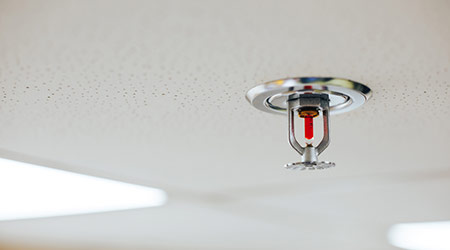All hospitals strive for 100 percent compliance. Having a safe, functional environment to provide the best care possible to patients is the ultimate goal for caregivers and executives alike. But “establishing and maintaining a safe, functional environment” is not as easy as it seems. In fact, 70 percent of hospitals surveyed by the Joint Commission in 2017 were not-compliant with this requirement. The top five requirements identified as “not compliant” for hospital accreditation surveys are:
1. The hospital provides and maintains systems for extinguishing fires: 86 percent non-compliant
2. The hospital manages risks associated with its utility systems: 73 percent non-compliant
3. The hospital provides and maintains building features to protect individuals from the hazards of fire and smoke: 72 percent non-compliant
4. The hospital reduces the risk of infections associated with medical equipment, devices and supplies: 72 percent non-compliant
5. The hospital established and maintains a safe, functional environment: 70 percent non-compliant
This does not mean hospitals are unsafe or fire hazards. It means they are falling short of the Joint Commission’s requirements and benchmarks to strive toward.
There is a theme running through these requirements that is hard to overlook: systems. Whether for fire safety or medical equipment, these systems can require extensive testing and maintenance. Often, hospitals outsource management of these systems to third-party vendors where inconsistencies can arise, leading to non-compliance. However, these snags can be mitigated to help your hospital reach compliance.
Streamline and expedite reporting
It’s not just anecdotal, and it’s not just your facility. The biggest compliance headache for hospitals in 2017 was maintaining systems for extinguishing fires. Also high on the list was maintaining building features to protect from fire and smoke hazards – think fire alarms and sprinkler systems. Who do you have testing those systems? It’s likely a third-party vendor. Although the ideal approach to all third-party-reliant procedures is to bring those in-house, it often is not budget friendly to do so specifically for fire alarm testing. So, what is the biggest problem with those third-parties? Reporting.
No matter the size of the hospital or system, it can take huge amounts of time to receive testing reports. For example, if a vendor comes in on the first of the month, you may not get a report for 30 to 60 days. The problem lies in that the vendor has identified issues that need to be addressed that day. It could be a matter of life and death to make those changes, which means 30 to 60 days where your facility could be unsafe from fire.
When working with a third-party vendor for sprinkler or fire alarm testing, put a non-negotiable timeline in place for vendors to complete and share their reports as soon as possible. At the very least, have the vendor make you aware of any failures that day so you can execute the appropriate interim life safety measures (ILSMs) immediately to protect patients, staff and visitors before the full report.
Establish consistency across vendors and locations
Even in large companies that operate on standardized protocols, it can be difficult to obtain consistent reporting from third-party vendors. Sometimes even simple compliance benchmarks, such as pass/fail or response times can be reported inconsistently from location to location. It becomes a greater hurdle when multiple facilities employ individual vendors which are different from facilities in a different region.
Lack in consistency can lead to oversights, both in your facility and for a TJC commission survey. You never want to go into a survey with a report that doesn't provide the appropriate or adequate information. That leads to inquiries which lead to more work to fix something that may not have actually been broken.
For fire alarm, sprinkler and even med gas testing, work with your vendors to provide consistent information across reports and locations. This may mean cultivating a stronger relationship with your vendor to file reports in a new way, but it is an investment of time that will pay dividends, especially when it comes to your next survey.
Find the best partner
Not every vendor is going to be the perfect fit for every facility. It’s not wrong to recognize that fact and search for a new partner that is a better fit. If consistency and reporting continue to be an issue, take a look at your vendors. Does your facility utilize four or five vendors across different reporting functions? Reducing the number of vendors to one or two will immediately streamline disparate reporting and lengthy timelines. With a heavy reliance on reports, don’t forget to take the ability of a vendor’s technicians and the quality of their work into consideration – the report is only as good as their ability to fix what’s wrong. Again, budgeting could play a role here, but it is worth it to crunch the numbers to see which vendors perform the best with the best reporting for the best price.
It’s unlikely that every system in your hospital can be run in-house, but for the safety of your patients and employees, there are several elements that should remain non-negotiable. Ensure your relationships with your vendors are strong and beneficial to your facility, then work with them to establish consistent, streamlined, and timely reporting.
Larry Lacombe is the Vice President of Program Development and Facilities Compliance at Medxcel.

 Grounding Healthcare Spaces in Hospitality Principles
Grounding Healthcare Spaces in Hospitality Principles UC Davis Health Selects Rudolph and Sletten for Central Utility Plant Expansion
UC Davis Health Selects Rudolph and Sletten for Central Utility Plant Expansion Cape Cod Healthcare Opens Upper 2 Floors of Edwin Barbey Patient Care Pavilion
Cape Cod Healthcare Opens Upper 2 Floors of Edwin Barbey Patient Care Pavilion Building Sustainable Healthcare for an Aging Population
Building Sustainable Healthcare for an Aging Population Froedtert ThedaCare Announces Opening of ThedaCare Medical Center-Oshkosh
Froedtert ThedaCare Announces Opening of ThedaCare Medical Center-Oshkosh